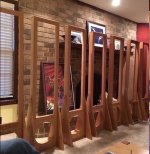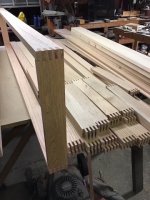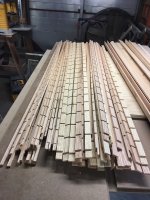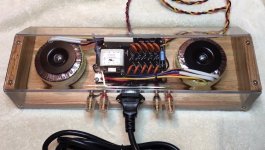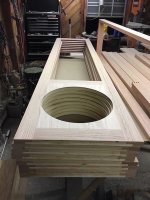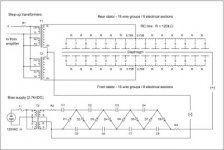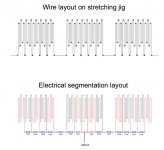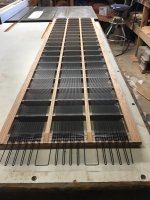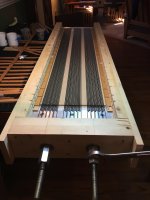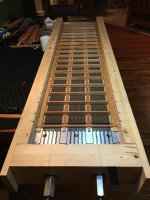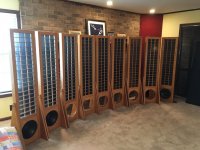Since October of last year I've been working on my biggest-ever speaker project, and in the coming weeks I will be posting some build photos, as the project nears completion.
Several of my Carver Audio buddies have begged me for years to build and sell them some speakers but up to now I've resisted because building them is exhausting, I'm not young anymore (66), and I still work full time. For better or worse; I've finally agreed to do it.
I'm about 90% done with building four (4) pairs of a hybrid design which uses a 12" woofer in an open baffle (modified H-baffle) configuration. The frames are solid oak and the stators are segmented wire type, supported by an oak lattice. At the end of the video below, a similar speaker which I built two years ago is shown playing-- the new speakers are a refined and slightly slimmer version of that design.
More to come, but for now; here's a video showing the wire stators being built:
YouTube
Enjoy!
Several of my Carver Audio buddies have begged me for years to build and sell them some speakers but up to now I've resisted because building them is exhausting, I'm not young anymore (66), and I still work full time. For better or worse; I've finally agreed to do it.
I'm about 90% done with building four (4) pairs of a hybrid design which uses a 12" woofer in an open baffle (modified H-baffle) configuration. The frames are solid oak and the stators are segmented wire type, supported by an oak lattice. At the end of the video below, a similar speaker which I built two years ago is shown playing-- the new speakers are a refined and slightly slimmer version of that design.
More to come, but for now; here's a video showing the wire stators being built:
YouTube
Enjoy!
Attachments
Last edited:
Do you have any pics of your builds
Yes, on my website here: Jazzman's DIY Electrostatic Loudspeaker Page
Just watched your video, great work
I’m near Daytona Beach and would love to spend a week or so with you and learn how your doing this
Great work from a great mind
I'll let you in on a little secret: Speaker designers love to show them off.
Carl, you have an open invitation to visit me in Savannah most anytime.
Charlie
Last edited:
Yes, on my website here: Jazzman's DIY Electrostatic Loudspeaker Page
Hi Charlie
Truly inspiring and do not want to distract you from the build, however I am interested in the panel segmentation you have adopted and how low you are handing off to the dipole base below.
The build video answered some of my questions, and you appear to have 3 identical width panels (independent segments actually I think) within each speaker. The central panel/segment is further divided electrically to yield a central "full range", down to where it crosses to the dipole woofer anyway, segment, with symmetrical segmenting either side for this panel and the adjacent two panel/segments, with progressively reducing hf/mf output.
Having handled a set of Acoustat panels that separated and miraculously I managed to glue back together and get to work again, I am in awe of your timber frames. that look like musical instruments. I am sure these will not be accused of having a "credit card sound", as HP famously once said of the Acoustat 2+2's.
So, my next question relates to just how low you take your panels and do the three sections have the lowest frequencies handled by the panels, or do you further restrict lower mid, or upper bass, on the central section, as Quad did with their admittedly much smaller central HF/MF?
Philosophically I struggle with people who say there is a "doppler" effect of having the same driver providing the "full range" of frequencies. The microphone is not set up to record individual frequencies and what it is recording is a single wave, at any one time, that is a combination of the different frequencies arriving at the microphone. So, separating them out and recombining them after the drivers, is not intuitively the right thing to do, unless your speaker drivers are unable to do full range, which all known drivers are incapable of including ESL's.
What you are doing, I think, is preserving the tracking of the microphone diaphragm, in your central segment of diaphragm, for as much of the frequency range your panel is capable of producing. The adjacent sectors are simply correcting the frequency response of this central segment (a falling MF/LF response), progressively down the frequency range, until finally handing over to the dipole, dynamic driver below.
Again, big ups an this inspiring work.
Regards
Grantn
Hello Grantin,
The attached schematics are for an earlier speaker design with the same panel arrangement. The new speakers will crossover a bit higher and use a 3.2kV bias supply.
Physically; the panel has three equal-width diaphragm sections, each driven by five (5) 6-wire groups. In total; 90 wires arrayed in 15 separate groups.
Electrically; the 15 wire groups are driven as: A single [six-wire] center group with seven left/right paired wire groups arrayed symmetrically on either side.
The center wire group is directly coupled to the amplifier interface and receives the full audio bandwidth above the crossover frequency. The paired groups on either side are powered in series through the center wire group.
Inserted between the wire groups are series resistors which couple with the wire/diaphragm capacitance (in parallel) to form a series of low-pass filters that progressively chop off the upper frequencies, toward the panel edges. This arrangement gives very smooth trending dispersion.
In effect; the panel's frequency/phase progression from the center to the edges approximates a line source projecting a cylindrical wave front. A couple of really smart ESL gurus on the DIY Audio Forum (a.k.a. "Boslerst" & "Golfnut") provided an Excel spreadsheet program which I used to design my panels.
Also; the segmentation scheme flattens the panel's frequency response, down to the low frequency cutoff. Whereas; an unsegmented flat panel tends to have a rising frequency response and very narrow sweet spot.
I plan to cross the panel over to the woofer at 235Hz using a 24db/octave Linkwitz-Riley filter slope. I will use a DSP crossover which gives a lot of tuning flexibility.
I built a similar OB woofer/ESL for a friend a couple of years ago (the one shown playing in the video) but I've never owned one myself or had an opportunity to audition them over time (I plan to keep one of the four pairs I'm currently building, though).
My current ESLs are also hybrids, with similar wire panels but they use 10" woofers in a transmission line. I'm looking forward to tuning the new OB speakers.
I figure the quasi-H baffle OB with a 12" woofer should be fairly adequate in bi-amp'd two way setup. But for my pair; I will use a tri-amp setup with Ripole subs handling the bottom two octaves.
The attached schematics are for an earlier speaker design with the same panel arrangement. The new speakers will crossover a bit higher and use a 3.2kV bias supply.
Physically; the panel has three equal-width diaphragm sections, each driven by five (5) 6-wire groups. In total; 90 wires arrayed in 15 separate groups.
Electrically; the 15 wire groups are driven as: A single [six-wire] center group with seven left/right paired wire groups arrayed symmetrically on either side.
The center wire group is directly coupled to the amplifier interface and receives the full audio bandwidth above the crossover frequency. The paired groups on either side are powered in series through the center wire group.
Inserted between the wire groups are series resistors which couple with the wire/diaphragm capacitance (in parallel) to form a series of low-pass filters that progressively chop off the upper frequencies, toward the panel edges. This arrangement gives very smooth trending dispersion.
In effect; the panel's frequency/phase progression from the center to the edges approximates a line source projecting a cylindrical wave front. A couple of really smart ESL gurus on the DIY Audio Forum (a.k.a. "Boslerst" & "Golfnut") provided an Excel spreadsheet program which I used to design my panels.
Also; the segmentation scheme flattens the panel's frequency response, down to the low frequency cutoff. Whereas; an unsegmented flat panel tends to have a rising frequency response and very narrow sweet spot.
I plan to cross the panel over to the woofer at 235Hz using a 24db/octave Linkwitz-Riley filter slope. I will use a DSP crossover which gives a lot of tuning flexibility.
I built a similar OB woofer/ESL for a friend a couple of years ago (the one shown playing in the video) but I've never owned one myself or had an opportunity to audition them over time (I plan to keep one of the four pairs I'm currently building, though).
My current ESLs are also hybrids, with similar wire panels but they use 10" woofers in a transmission line. I'm looking forward to tuning the new OB speakers.
I figure the quasi-H baffle OB with a 12" woofer should be fairly adequate in bi-amp'd two way setup. But for my pair; I will use a tri-amp setup with Ripole subs handling the bottom two octaves.
Attachments
Last edited:
Thanks for that Charlie.
I have been attempting something far less ambitious and failing for the last 4 years, but am now heading in the direction of using less Acoustat panels (2 per side) and handing over to Ripoles using the Peerless SLS drivers, 1 pair per side at about 60 to 80Hz. I will have to venture into the world of DSP I suspect as well, but that is some distance away.
Regards
Grant
I have been attempting something far less ambitious and failing for the last 4 years, but am now heading in the direction of using less Acoustat panels (2 per side) and handing over to Ripoles using the Peerless SLS drivers, 1 pair per side at about 60 to 80Hz. I will have to venture into the world of DSP I suspect as well, but that is some distance away.
Regards
Grant
Hello Grantin,
The attached schematics are for an earlier speaker design with the same panel arrangement. The new speakers will crossover a bit higher and use a 3.2kV bias supply.
Physically; the panel has three equal-width diaphragm sections, each driven by five (5) 6-wire groups. In total; 90 wires arrayed in 15 separate groups.
Electrically; the 15 wire groups are driven as: A single [six-wire] center group with seven left/right paired wire groups arrayed symmetrically on either side.
The center wire group is directly coupled to the amplifier interface and receives the full audio bandwidth above the crossover frequency. The paired groups on either side are powered in series through the center wire group.
Inserted between the wire groups are series resistors which couple with the wire/diaphragm capacitance (in parallel) to form a series of low-pass filters that progressively chop off the upper frequencies, toward the panel edges. This arrangement gives very smooth trending dispersion.
In effect; the panel's frequency/phase progression from the center to the edges approximates a line source projecting a cylindrical wave front. A couple of really smart ESL gurus on the DIY Audio Forum (a.k.a. "Boslerst" & "Golfnut") provided an Excel spreadsheet program which I used to design my panels.
Also; the segmentation scheme flattens the panel's frequency response, down to the low frequency cutoff. Whereas; an unsegmented flat panel tends to have a rising frequency response and very narrow sweet spot.
I plan to cross the panel over to the woofer at 235Hz using a 24db/octave Linkwitz-Riley filter slope. I will use a DSP crossover which gives a lot of tuning flexibility.
I built a similar OB woofer/ESL for a friend a couple of years ago (the one shown playing in the video) but I've never owned one myself or had an opportunity to audition them over time (I plan to keep one of the four pairs I'm currently building, though).
My current ESLs are also hybrids, with similar wire panels but they use 10" woofers in a transmission line. I'm looking forward to tuning the new OB speakers.
I figure the quasi-H baffle OB with a 12" woofer should be fairly adequate in bi-amp'd two way setup. But for my pair; I will use a tri-amp setup with Ripole subs handling the bottom two octaves.
Those are gorgeous speakers, are you taking orders for them? I’m sure I could not afford them anyway. Lol
Great work and thanks for the pic of how the resistors are for
I'll let you in on a little secret: Speaker designers love to show them off.
Carl, you have an open invitation to visit me in Savannah most anytime.
Charlie
Thanks Charlie
I just started reading your website, great information there, your a very modest man
Those are gorgeous speakers, are you taking orders for them? I’m sure I could not afford them anyway. Lol
Great work and thanks for the pic of how the resistors are for
I'll send my drawings and parts list to anyone who wants them but I'm swearing off building more speakers to sell... it's just too exhausting for an old guy like me.
Update Saturday March 14, 2020:
The panels and segmentation resistor networks are installed in all eight speakers. Today I installed Peerless SLS 12 woofers in one pair and they're playing tonight. I delayed ordering woofers for the remaining speakers until I've had a chance to audition these. My first impression is the SLS 12's will be fine.
I still have to build the grills but it feels good to be wrapping this project up after 5 months of toil.
The photo and video below were made today.. enjoy!
video
The panels and segmentation resistor networks are installed in all eight speakers. Today I installed Peerless SLS 12 woofers in one pair and they're playing tonight. I delayed ordering woofers for the remaining speakers until I've had a chance to audition these. My first impression is the SLS 12's will be fine.
I still have to build the grills but it feels good to be wrapping this project up after 5 months of toil.
The photo and video below were made today.. enjoy!
video
Attachments
Last edited:
- Status
- This old topic is closed. If you want to reopen this topic, contact a moderator using the "Report Post" button.
- Home
- Loudspeakers
- Planars & Exotics
- New speaker project underway
